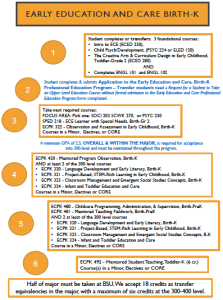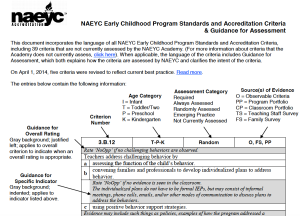Dr. Susan Eliason
This electronic textbook supports a required course at Bridgewater State University in the program of study for the Early Education and Care Birth-K major. The course, ECPK 420 Mentored Program Observation, Birth-K, Birth-PreK, consists of observations in six different Birth-K settings across the mixed delivery system of early childhood education. Students compare their experiences and submit a portfolio analyzing the settings they visit. They analyze quality using national early childhood accreditation standards. The course is designated as fulfilling the writing intensive course in the major.
ECPK 420 is designed so students experience and reflect upon the full range of childcare delivery models, birth through kindergarten. Some students may have experienced only one type of early childhood setting. Part of becoming a professional in the field is developing “The Big Picture” and realizing there are many ways to provide quality services for children. We work together, to make sure children and families in our community are served effectively.
Below is a graphic detailing previous coursework. Students take foundational coursework and some of the methods courses before enrolling in ECPK 420 which will lead to fieldwork or student teaching in the next semester.

In this course, students will be using the National Association for the Education of Young Children (NAEYC) national standards to evaluate childcare programs as well as comparing what they know about the Department of Early Education and Care (EEC) childcare regulations in the Commonwealth of Massachusetts.
To complete readings and challenges offered in the course, students need to use the document from the National Association for the Education of Young Children. (2017, April) NAEYC Early Learning Program Standards and Criteria. Washington, DC: Author. You will also want to review the NAEYC Observable Criteria Tools website and to consider using the appropriate checklist during observation visits.

The documents and materials in the Appendices will be helpful as you prepare to do the observations. Review and become familiar with all the items.
The Learning Outcomes for ECPK 420 are: Student will
- Recognize, document, analyze, and evaluate national best practices in early childhood education, in a variety of delivery models, by observing in programs serving diverse children from birth through kindergarten including children with special needs and dual language learners.
- Describe local systems serving children and local resources available to early educators and families.
- Explain local transition services and screening procedures in early childhood programs.
- Observe and critique pedagogical approaches in early childhood settings.
- Recognize and analyze ethical and unethical professional behaviors in early childhood settings.
The Learning Outcomes are assessed throughout the semester by:
- Blackboard Discussions;
- 6 Narratives (See descriptions below);
- Participation including 2 Class presentations
Portfolio Narratives
Narrative 1: POSITIVE RELATIONSHIPS/INTERACTIONS from 1 observational site
Describe and analyze the practices, policies, materials and/or activities that support the teachers’ abilities to: build positive relationships with families; build positive relationships with children; build positive child to child relationships; and effectively manage a positive learning environment.
Narrative 2: THE PHYSICAL ENVIRONMENT/HEALTH AND SAFETY from 1 observational site
Describe and analyze the practices, policies, materials and/or activities that support: the indoor learning environment; the outdoor learning environment; as well as proper sanitation, nutrition, and safety.
Narrative 3: OBSERVATION, DOCUMENTATION AND ASSESSMENT from 1 observational site
Describe and analyze the practices, policies, materials and/or activities that support the teachers’ abilities to: observe; document; and assess child development and growth.
Narrative 4: CURRICULUM from 1 observational site
Describe and analyze the practices, policies, materials and/or activities that support the teachers’ abilities to: use child assessment to inform curriculum development; design quality learning environments that support the content areas.
Narrative 5: INSTRUCTION from 1 observational site
Describe and analyze the practices, policies, materials and/or activities that support the teachers’ abilities to: provide active learning experiences; use time appropriately during grouping, transitions, and routines; and provide proper child supervision.
Narrative 6: UNIVERSAL DESIGN FOR LEARNING (UDL) AND SOCIAL-EMOTIONAL DEVELOPMENT from 1 observational site
Describe and analyze the practices, policies, materials and/or activities that support the teachers’ abilities to: create developmentally appropriate adaptations to the curriculum, materials, program structure and/or policies to support children’s individual strengths, interests and needs; and foster children’s emotional well-being.
To prepare for the course, here is a letter from former students.
December, 2016
Dear Future ECPK 420 Students:
Please be prepared to expand your thinking of yourself as a student and as a teacher. It was great to visit the six different sites and to learn from each one of them. Some of the settings were inspirational. After visiting the sites the hardest part was to write about each different one objectively. Take a lot of detailed notes while you are onsite. They are good to come back to, as it is hard to remember every detail of what you are observing. Notice all aspects of the classroom, print out the NAEYC standards and bring them with you. If you don’t see something, ask the teacher, I found them to be friendly and helpful.
Do your observations as soon as you can. One visit per week is a good pace, as it gives time to digest what was seen and heard. Get your observation sites confirmed quickly, some sites may have unforeseen issues, take that into account. Most of all enjoy your site visits. It may be the only opportunity you get to compare firsthand the different types of early childhood settings.
A major portion of the course is receiving feedback from your professor and peers. At first when I received feedback I thought how will I rewrite this paper? Initially the feedback on the narratives, was a shock or surprise. Handing in my papers I had good feeling, as if the papers were right on point and never too wordy, or the papers were perfect. I did my best and took pride in my work. I do not like being told I am doing something wrong, it always makes me uncomfortable, but the feedback I received was only helpful, it helped me to see that my writing was not “perfect,” I did need to review and edit.
So, I learned to appreciate all the feedback and used it to improve. I learned not to take the feedback personally. It helped me look deeper look into my writing, while getting insight from peers. I used most of the feedback from my peers, but I used the professor’s knowledge to become a better student. It helped me to rethink what I saw and how I could write about the topic effectively. I found the comments to be specific and clear as to the strengths and weaknesses of my writing. After all, it would be silly on your part to ignore anything a professor offers.
One of my favorite parts of the class was the discussion board, as the other students in the class had a lot to offer and there was never enough time in class to thoroughly discuss each subject. The discussion boards are a good way to gain insight on a theory or subject that has been puzzling you. Remember to post your discussion early in the week to get the maximum points for your work.
Ideas for how to be successful in ECPK 420.
- Relax and enjoy the class. Have fun. Get to know your peers and professor. You can learn a lot of just talking to other people in the room. Your peers are a wealth of knowledge. Chances are they might not understand something and or they might have ideas you haven’t tried.
- Never be afraid to ask for help. Professors aren’t mind readings if you don’t understand something speak up or email or talk to them in person. They are there to help and they don’t want to watch you fail.
- Manage your time wisely. Write up you narrative as soon as possible after observing. Just get your thoughts on paper. You can go back a day or two later and edit. Don’t leave everything until the last minutes. This course is planned to have something to hand in every week. Keep up and don’t fall behind, because if you do or going to feel lost.
- Don’t look too far ahead in the course. Take it one week at a time, it looks like a lot and it is. However, it is planned to make it not look so scary.
- Utilize your resources, the professor and your peers are very helpful, and willing to support you.
- You will be doing observations, prepare accordingly with your place of employment.
- If there is a need to request an extension, make sure it is far enough in advance so to not get too far behind.
- The more you put into the class the more you will get out of it.
Sincerely,
The Fall 2016 ECPK 420 Class
How much time studying?
Assume about 50 pages of reading a week, 60 pages of writing per semester with editing, and 1 assignment per week. Plan to spend at least 6 hours a week learning in our course, you may spend much more!
